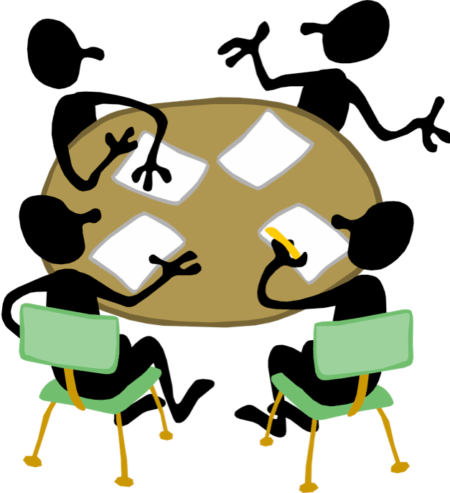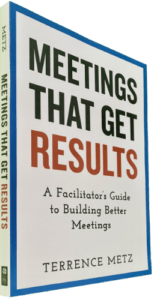Meetings are frequently a fix for poor leadership. Most would rather go to a movie than sit in a two-hour meeting. Almost all poor movies at least contain a beginning, middle, and end. Indirect meeting costs represent a huge area for cost control and improved return on investment.
Meetings are very expensive. Today’s business world is asymmetric, and holding meetings to share information may be a poor use of precious resources. Dashboard devices provide a better means for information updates than staff meetings. The Scrum approach addresses three questions during daily Scrums, but participants frequently remain standing so that meetings adjourn quickly:
- What has been accomplished since we last met?
- What accomplishments are targeted next?
- Which challenges require additional support?

Indirect Meeting Costs and Challenges
The best reason to pull people together is to build something that we cannot do apart, to arrive at consensus, to decide on something. Consider replacing weekly meetings with periodic workshops, knowing that the use of facilitators greatly improves productivity.
Role of Meetings
We live in a meeting society. Along with billions of people, our world also contains more than 200 nation-states, 4 million local communities, 20 million economic organizations, 200 million extended families, and hundreds of millions of other formal and informal groups. In order for groups to exist, individuals that make up these groups must meet and interact.
Current Trends
The increased growth in the number and length of meetings is due to the accelerated rate of change that now rules today’s business environment. The rapid and constant change in technology, particularly information technology and business process management, has dramatically increased the volatility of the global marketplace. As technology takes over more routine functions and allows faster access to data, managerial skills shift, calling for increased communication clarity and small group skills.
Flatter Structures
Another trend emerging as a result of an accelerated environment is the growth of more efficient and flatter organizational structures. These organizations have fewer management layers and, therefore fewer levels of decision-making. Flatter structures result in more group decision-making by specialists from disparate areas within the organization. Consequently, the ability to effectively communicate cross-functional support in meetings has taken on increased importance.
Participative Management
A by-product of replacing hierarchy with holarchy is an increasing emphasis on participative employee ownership. Participative management bases itself on the following premises:
- The quality of decisions is improved if all employee expertise is considered, and
- The act of employee participation leads to better acceptance of the decisions.
50 Percent Productive
Studies have estimated that meetings are at most 50 percent productive. Thus the typical manager wastes approximately 240 hours per year (about 30 days) at a cost to the average Fortune 500 Company of greater than one hundred billion USD per year. By using proper meeting management, a single company could recover 25 to 35 percent of these costs or hundreds of millions per year.
Intangible Costs
The intangible costs associated with poor meeting management are overlooked at all levels of management. Meetings serve as opportunities for senior management to appraise and search out potential leaders within an organization. As lower-level managers take on more responsibilities, they spend more of their time in meetings with executives at higher levels. Consequently, their success as executives is tied to their ability to make the most out of their meeting time.
Psychological Costs
Participating in a poorly run meeting is frustrating, resulting in apathy, resentment, and a lack of commitment toward the meeting’s outcome. This attitude carries over to the workplace. Therefore, in many cases, subverting good ideas that come from the meetings.
Meeting Dementia
People and organizations have developed “meeting dementia because poorly run meetings have been around for so long and remain prevalent. Some view poorly run and unproductive meetings as the norm, and that’s just the way it is. This viewpoint seems to have been inherited by observing others who have led poorly run meetings, who in turn learned from others making the same mistakes, and so on.
Indirect Meeting Costs and Challenges
The major problems with meetings, surprisingly, don’t have to do with personalities or the inability of group members to get along with one another. Almost all problems are typically task-related—i.e., people do not know the mechanics of HOW TO lead effective meetings. The following list highlights 14 of the most frequently mentioned problems by over 1,000 managers:
- Getting off subject
- No goals or agenda
- Too long
- Poor preparation
- Inconclusive
- Disorganized
- Ineffective leader/ lack of control
- Irrelevant information discussed
- Time wasted
- Started late
- Ineffective for making decisions
- Interruptions (inside and out)
- Dominators
- Rambling discussion
______
Don’t ruin your career by hosting bad meetings. Sign up for a workshop or send this to someone who should. MGRUSH workshops focus on meeting design and practice. Each person practices tools, methods, and activities every day during the week. Therefore, while some call this immersion, we call it the road to building high-value facilitation skills.
Our workshops also provide a superb way to earn up to 40 SEUs from the Scrum Alliance, 40 CDUs from IIBA, 40 Continuous Learning Points (CLPs) based on Federal Acquisition Certification Continuous Professional Learning Requirements using Training and Education activities, 40 Professional Development Units (PDUs) from SAVE International, as well as 4.0 CEUs for other professions. (See workshop and Reference Manual descriptions for details.)
Want a free 10-minute break timer? Sign up for our once-monthly newsletter HERE and receive a timer along with four other of our favorite facilitation tools, free.

Terrence Metz, president of MG RUSH Facilitation Training, was just 22-years-old and working as a Sales Engineer at Honeywell when he recognized a widespread problem—most meetings were ineffective and poorly led, wasting both time and company resources. However, he also observed meetings that worked. What set them apart? A well-prepared leader who structured the session to ensure participants contributed meaningfully and achieved clear outcomes.
Throughout his career, Metz, who earned an MBA from Kellogg (Northwestern University) experienced and also trained in various facilitation techniques. In 2004, he purchased MG RUSH where he shifted his focus toward improving established meeting designs and building a curriculum that would teach others how to lead, facilitate, and structure meetings that drive results. His expertise in training world-class facilitators led to the 2020 publication of Meetings That Get Results: A Guide to Building Better Meetings, a comprehensive resource on effectively building consensus.
Grounded in the principle that “nobody is smarter than everybody,” the book details the why, what, and how of building consensus when making decisions, planning, and solving problems. Along with a Participant’s Guide and supplemental workshops, it supports learning from foundational awareness to professional certification.
Metz’s first book, Change or Die: A Business Process Improvement Manual, tackled the challenges of process optimization. His upcoming book, Catalyst: Facilitating Innovation, focuses on meetings and workshops that don’t simply end when time runs out but conclude with actionable next steps and clear assignments—ensuring progress beyond discussions and ideas.




This says much about organisational culture. Manager recognise the problems with meetings yet do nothing about it. Why is this? Is it a lack of training or an unwillingness to challenge practice within the organisation?